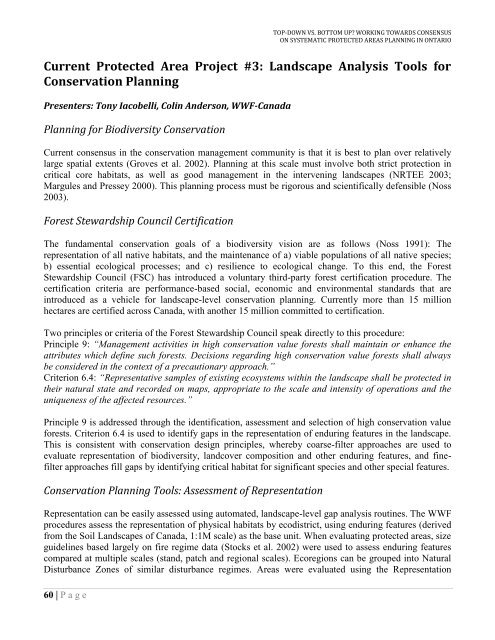Top-Down vs. Bottom Up: Working Towards Consensus ... - CASIOPA
Top-Down vs. Bottom Up: Working Towards Consensus ... - CASIOPA
Top-Down vs. Bottom Up: Working Towards Consensus ... - CASIOPA
- No tags were found...
Create successful ePaper yourself
Turn your PDF publications into a flip-book with our unique Google optimized e-Paper software.
TOP-DOWN VS. BOTTOM UP? WORKING TOWARDS CONSENSUSON SYSTEMATIC PROTECTED AREAS PLANNING IN ONTARIOCurrent Protected Area Project #3: Landscape Analysis Tools forConservation PlanningPresenters: Tony Iacobelli, Colin Anderson, WWF-CanadaPlanning for Biodiversity ConservationCurrent consensus in the conservation management community is that it is best to plan over relativelylarge spatial extents (Groves et al. 2002). Planning at this scale must involve both strict protection incritical core habitats, as well as good management in the intervening landscapes (NRTEE 2003;Margules and Pressey 2000). This planning process must be rigorous and scientifically defensible (Noss2003).Forest Stewardship Council CertificationThe fundamental conservation goals of a biodiversity vision are as follows (Noss 1991): Therepresentation of all native habitats, and the maintenance of a) viable populations of all native species;b) essential ecological processes; and c) resilience to ecological change. To this end, the ForestStewardship Council (FSC) has introduced a voluntary third-party forest certification procedure. Thecertification criteria are performance-based social, economic and environmental standards that areintroduced as a vehicle for landscape-level conservation planning. Currently more than 15 millionhectares are certified across Canada, with another 15 million committed to certification.Two principles or criteria of the Forest Stewardship Council speak directly to this procedure:Principle 9: “Management activities in high conservation value forests shall maintain or enhance theattributes which define such forests. Decisions regarding high conservation value forests shall alwaysbe considered in the context of a precautionary approach.”Criterion 6.4: “Representative samples of existing ecosystems within the landscape shall be protected intheir natural state and recorded on maps, appropriate to the scale and intensity of operations and theuniqueness of the affected resources.”Principle 9 is addressed through the identification, assessment and selection of high conservation valueforests. Criterion 6.4 is used to identify gaps in the representation of enduring features in the landscape.This is consistent with conservation design principles, whereby coarse-filter approaches are used toevaluate representation of biodiversity, landcover composition and other enduring features, and finefilterapproaches fill gaps by identifying critical habitat for significant species and other special features.Conservation Planning Tools: Assessment of RepresentationRepresentation can be easily assessed using automated, landscape-level gap analysis routines. The WWFprocedures assess the representation of physical habitats by ecodistrict, using enduring features (derivedfrom the Soil Landscapes of Canada, 1:1M scale) as the base unit. When evaluating protected areas, sizeguidelines based largely on fire regime data (Stocks et al. 2002) were used to assess enduring featurescompared at multiple scales (stand, patch and regional scales). Ecoregions can be grouped into NaturalDisturbance Zones of similar disturbance regimes. Areas were evaluated using the Representation60 | P a g e


